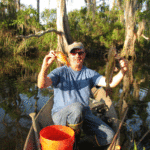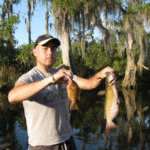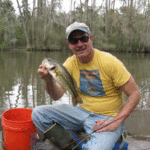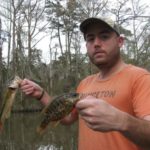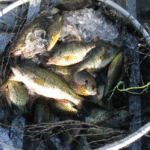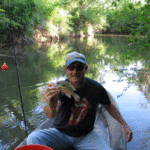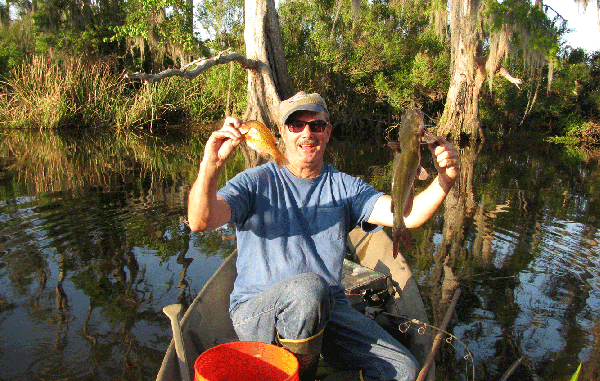
There’s absolutely nothing to not love about Bedico Creek in April.
Pelayo motioned me over with frantic gestures and wide eyes. Then he managed a frozen smile and turned back to the conversation with Artie’s spanking-new brother-in-law, Steve.
Pelayo fancied himself sneaky and discreet, but his arm motions looked like a traffic cop giving the “come-on” signal and now his smile mimicked the face of an Oscar-nominated actor when the camera zooms in for a close-up as the envelope opens — announcing that he lost.
I walked over, started listening to Steve’s conversation, and gaped in shock. Yes, Pelayo had a point. Steve’s questions seemed genuinely inquisitive rather than rhetorical. He actually listened to the answers, calmly and earnestly. He smilingly admitted much ignorance on many subjects. His tone of voice and facial expression were utterly free of cynicism.
Steve did not boast expertise in every field of human endeavor from hunting to fishing, from frogging to spearfishing, from football-coaching to aereodynamics, from hydromechanics to microbiology, from outboard repair to box-stand design, from food-plot fertilization to bullet ballistics, from gadwall cookery to gazebo carpentry. He did not claim superiority in skill, knowledge, finesse, insight and wisdom in their lines of work over everyone from Sean Payton to Emeril Lagasse, from Bill Dance to Ernest Hemingway, from Les Miles to George Patton, from Henry Kissinger to “Lucky” Liz Cavalier, from Werner Von Braun to “Trapper” Joe LaFont, from Albert Einstein to Troy Landry. His demeanor and manner of speaking revealed no trace of bombast, bravado or know-it-all-ism.
There seemed only one explanation for this bizarre speech, thought and behavior pattern: Steve was obviously from out-of-state.
North Carolina, we soon learned. When he whipped out his iPhone and started the pictures of the “bream” he catches in the lakes “back home,” we freaked. The things almost looked like sheepshead, minus the stripes.
“Naw, Steve,” Artie told his brother-in-law while patting him on the back. “We don’t catch ‘em nearly that size around here. But we catch plenty of ‘em. Everything in our swamps and marshes is more abundant than in higher and drier latitudes — but typically smaller. This goes for everything from bass to perch to frogs to deer.”
Artie had a point. When he whipped out his own iPhone to show off our recent catch from the Bedico Creek-Lower Tangipahoa River area, Steve nodded politely but begged-off from joining us the following evening for some swamp-touring/panfishing.
“But I’ll be back in a coupla weeks for Jazz Fest,” he reminded us. “John Mellencamp’s playing. I can’t wait to see him! Should be good.”
“Should be pathetic!” countered Eddie. “He’ll probably play all his later pinko stuff — rather than his early fun stuff. You watch!”
“We’ll see,” Steve waved while walking toward Trisha and Priscilla near the serving table and rapidly vanishing button-buck fajitas. The gals would be the ones escorting Steve to Jazz Fest.
“Forget it this week,” Artie admonished us as we got back to fishing talk. “This rain’s got the Tangi River swollen and muddy. Better wait for it to drop.”
But that’s the beauty of fishing the Tangipahoa River’s tributary Bedico Creek, which originates much farther south and drains a much smaller watershed. Hence even when the Tangipahoa River looks like chocolate milk, the creek’s waters still resemble root beer, and the green trout, perch, cats and goggleye (especially goggleye) remain in serious feeding mode. Tempt them with baits no more exotic (or easy to get and rig) than shrimp-sweetened mini-jigs a coupla feet under a little cork, and it’s practically impossible to return from this area without the raw materials for a friends-and-family fish fry. On “bad” days, you’ll still easily stuff two po-boys with results, at least in our experience.
“Food and cover,” we’re told time and again, are the essentials for any creature — from deer to gadwall — to thrive and propagate. In this easternmost extreme of the Maurepas swamp, panfish have both in great abundance. Think of our offshore oil platforms and what they provide saltwater fish. Well, cypress trees provide much the same for freshwater fish. On the surface, you see a cypress trunk and maybe a few knees. But under that is a network of knees and roots extending well out from the trunk itself, and providing great cover and structure.
This area also qualifies as an “overflow swamp” — and a gorgeous one from Swamp Tour central casting. Such habitat always produces the most panfish because it provides the most food and cover for panfish, especially food. That huge swamp is a breeding ground for an enormous buffet of insects, crustaceans, snails, frogs, salamanders, worms — you name it.
The water comes up, overflows into that flooded swamp, and the panfish have a feast. The water starts dropping, and this buffet channels into the network of little sloughs and trenasses. You don’t find this phenomenon in completely land-locked ponds or lakes or creeks or rivers. They might produce plenty of panfish — but nothing like in overflow swamps.
Better yet, the Lower Tangipahoa and Bedico Creek are bona-fide natural streams. One’s called a river, the other a creek. But in fact, below Highway 22, they both look no different from a typical swamp bayou, and without any channelization to mar their banks. The canals we often fish in swamp settings are hardly bereft of structure, but the cypress and tupelo Gums don’t extend out into the water, providing that valuable structure and gorgeous panorama. The long-ago dredging or channelization did away with them. But in this area, this structure remains in most of its original glory.
Oddly a (light) rain actually helps the fishing in the upper reaches of the Tangipahoa and Bedico Creek — the stretches north of Highway 22 that meander through sandy-soiled pine uplands. In these barren, sandy-bottomed streams without aquatic vegetation or adjacent swamplands, fish feed most actively when rain washes in food from the surrounding woods, branches and ravines. The rest of the time they have to make do with the few forage fish and insects along the banks.
These upper reaches like most streams in the Florida parishes aren’t like those in the Atchafalaya or Maurepas basins, or in other similar swamps also known as “spillover” wetlands. In these, as mentioned, high tides give the panfish access to that broth of fish fodder (minnows, crawfish, terrestrial and aquatic insects, larvae, etc.) that lives in the shallow, fertile, weed-clogged pools and sloughs in the surrounding swamp.
But in upland streams, the fish have to wait for the rain to wash this type of stuff in from the surrounding woods, branches, ditches, ravines, etc. So the sound of rain is almost like a dinner bell.
Another option around here is to head out the mouth of the Tangipahoa River to Lake Pontchartrain itself for saltwater action.
“I like topwater baits in that area, Hom-Boy-da,” says Mandeville’s Bill Hungerford, the man regarded by many as the elder statesman of Northshore fishermen — especially regarding the western portion of the lake. “You get a north wind for a few days, or no wind for a few days, and this is the area I like to fish. Say roughly from the mouth of the Tchefuncte River to the mouth of Pass Manchac.
“During the spring, I often catch big specks in this area. They’re spawning at the time along this shoreline. Plenty structure in this area. Hundreds of years ago, the cypress trees extended far into what is now the lake, kinda like they still do in places like Verret, Des Allemands and Maurepas. Their stumps are the only thing that remain nowadays, and they provide great structure for fishing. As you know, redfish love crabs. And crabs find these eroded stumps great places to hide in. The reds aren’t far behind.
“Lots of pilings extend out into the lake from the piers of some long-gone camps that used to dot this lakeshore. When the water clears up, you can see the remnants of these pilings underwater. They’re my favorite places to fish out here.
“It’s mainly mullet and pogies that the trout, reds and a few stripers feed on in this area. Since the fish are feeding on mullets and pogies, I like topwater baits out here. They work best for me. The Top Dog, of course, is good, but so are the broke-back plugs. Any of those floating or slow-sinking MirrOlures work well for me out here — basically anything that mimics a small mullet.”
Alas, the winds had been southeasterly so we decided to stick with panfish. From Traino Landing we headed south on Bedico Creek. Crawfish-mimicking rubber jigs under jigging poles take top prize as the favored combo in this area, as amply proven by the folks we passed (slowly, wakelessly) on the way down-creek. About a half mile from the landing, what some locals call the “Pine Island Canal” hits the eastern shore of Bedico Creek and technically links it to the Techefuncte River through the Madisonville “rice-field” area. Its mouth is usually a good place to start, but two boats had beat us. So on we cruised for about another mile.
Pelayo finally whipped out the trolling motor, and we started casting. Pelayo concentrated on casting outside the border of lily pads (yes bona-fide water lilies, not what most of us call lilies, which are actually water hyacinths) with a spinnerbait, while I targeted the area between the lily pads and the cypress trunks near the bank. A high tide in this area means more fishable water, because the bayou spills over into the tree-studded swamp and thus the preferred habitat for bluegill and goggleye. And such conditions we enjoyed today.
On my first cast from my ultralight spinning outfit, the cork and shrimp-sweetened mini-jig bounced off a tupelo trunk.
The cork hit the water, twitched twice — and vanished.
“They’re HERE!” I howled. “Don’t take long, my friend!” The battle was joined.
Now what kind of lunatic would describe the process of reeling in an 8-inch fish on 6-pound-test line as a “battle?”
A fanatical panfishermen, that’s who. Soon I was unhooking a chunky, multi-colored goggleye as Pelayo whooped and pointed his chin as the green trout on the end of his line leaped among the lily pads — quickly snagging his line, escaping and ending the whooping session. The little fillets lovingly flayed from my goggleye would fry up gorgeously, unless I decided to scale him and fry him up whole, to savor the skin, crunchy with salt, lemon and “gaaaw-lic.”
“Another one here!” yelled Pelayo, and I turned in time to see his little bass leap and cartwheel twice, then go into a frenzy of lunges and surface thrashing until Pelayo hoisted him aboard triumphantly. “Told you these little spinnerbaits were the ticket!”
Twenty minutes later, we came upon a little cove studded with old cypress stumps. The place had goggleye written all over it. My cork and Pelayo’s spinnerbait landed on either side of a stump. Two “pops” into my retreive, and three cranks into Pelayo’s, we both hooked up, and the whooping started anew.
Pelayo was soon swinging aboard a goggleye as the green trout on the end of my line thrashed and lunged along the surface. The little bass fell for a shrimp-sweetened chartreuse mini jig. Pelayo’s googleeye gobbled a purple/gold spinnerbait. Go figure. That’s the beauty of fishing this area. You’re never completely sure of what’s going to clobber your bait — but ALL will fry up deliciously. In fact, my shrimp-tipped mini jig caught channel cats, goggleye, lakerunners and bluegill. Even a couple of (small) wayward sac-a-lait seemed to prefer my offering.
The scenery and the catching were getting us giddy. Again my little bobber hit near a lily pad, bobbed twice, actually jumped out of the “waaaw-da” and vanished.
“Hey, hey!” I yelled while setting the hook.
Then he started tugging and lunging and, finally, thrashing the surface. In minutes I hoisted a gorgeous channel cat toward Pelayo, who seemed impressed, even while unhooking a dark “bull bream” that somehow inhaled his spinnerbait. Another half mile downstream, Pelayo switched to a shrimp-tipped mini jig, and started casting near the stumps.
“YEAH!” he beamed as his little reel started singing. “They’re here, podnuh!”
But his wasn’t jumping, just slashing back and forth, a little surface thrashing. Then back under for some spirited runs. I swung in a big bluegill as Pelayo jerked aboard his chunky goggleeye (these will never beat Atchafalaya Basin goggleye in the size department — but they’re still plenty nice by our standards). The little sucker wasn’t 10 inches long. But we were all smiles.
My next cast nailed a little yellow bass within seconds of hitting the water. Pelayo was on another bluegill in short order. Then his drag started singing — “oh, oh!” he frowned. “Looks — and sounds — like a choupique!”
Instead he was soon dipping the net under another perfect-sized channel cat. Then came a chunky lakerunner (red-eared sunfish.) My next fish after re-sweetening my jig was another big maroon-bellied bluegill.
All these panfish seem to like the same type of food flowing from this overflow swamp into Bedico Creek. Our shrimp-tipped jigs seemed to perfectly mimic this panfish feast, and we were amply rewarded with a couple dozen delicious panfish during an immensely enjoyable and scenic swamp-tour — that also provided the makings of a dy-no-mite fish fry.
